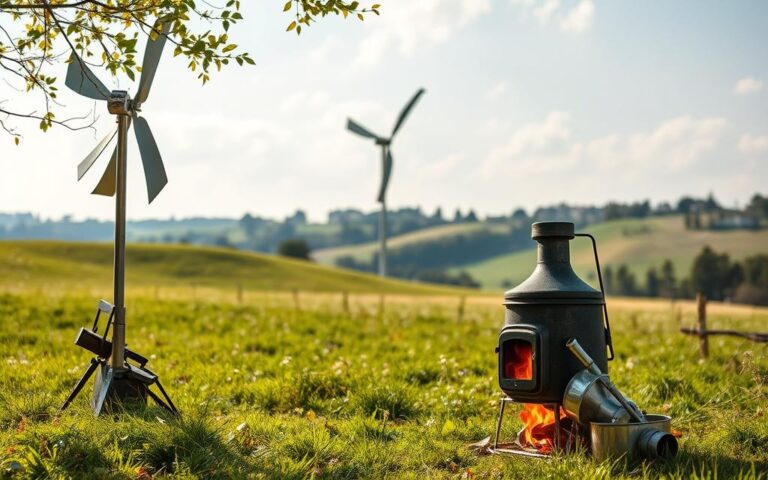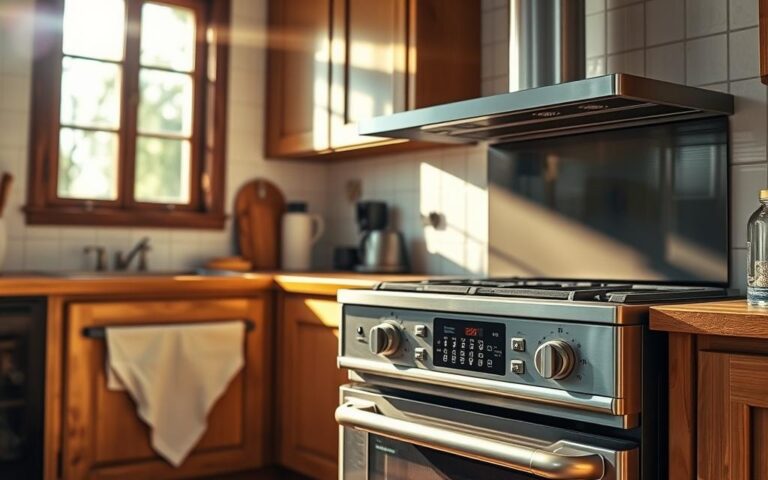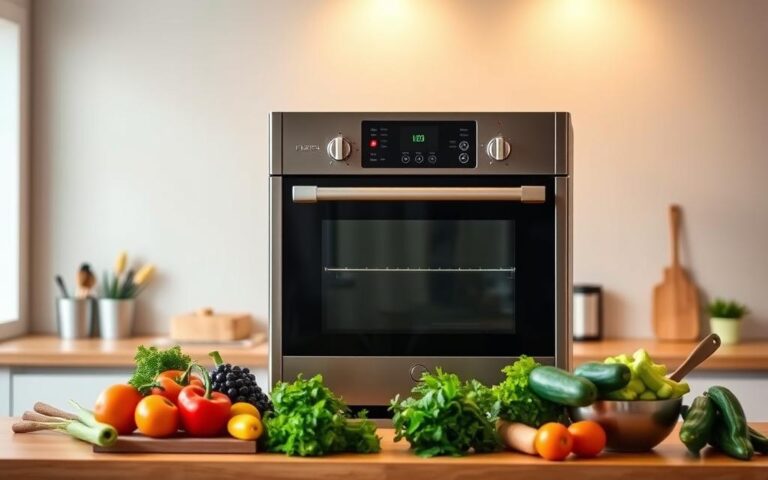Millions cook with open fires or inefficient stoves, causing environmental and health issues. A homemade solar cooker offers an innovative solution to this problem. It’s an eco-friendly way to cook and reduce energy use.
This DIY project turns everyday items into a sustainable cooking device. It’s perfect for those interested in green living or renewable energy. You’ll learn to make a solar oven with common household materials.
Our guide shows how to repurpose items destined for landfills. You’ll create a working cooker and help cut waste and emissions. The process is easy and needs few technical skills.
We’ll teach you to be a solar cooking pro. You’ll learn basic principles and how to build an efficient oven. Get ready for a fun and educational adventure!
Introduction to DIY Solar Ovens
Solar cooking uses the sun’s energy to prepare meals. It’s an eco-friendly way to cook without traditional methods. Sun ovens turn sunlight into heat, letting you make tasty dishes while helping the environment.
Solar cooking offers new ways to prepare food sustainably. These clever devices capture sunlight and turn it into heat. This heat can cook many types of food.
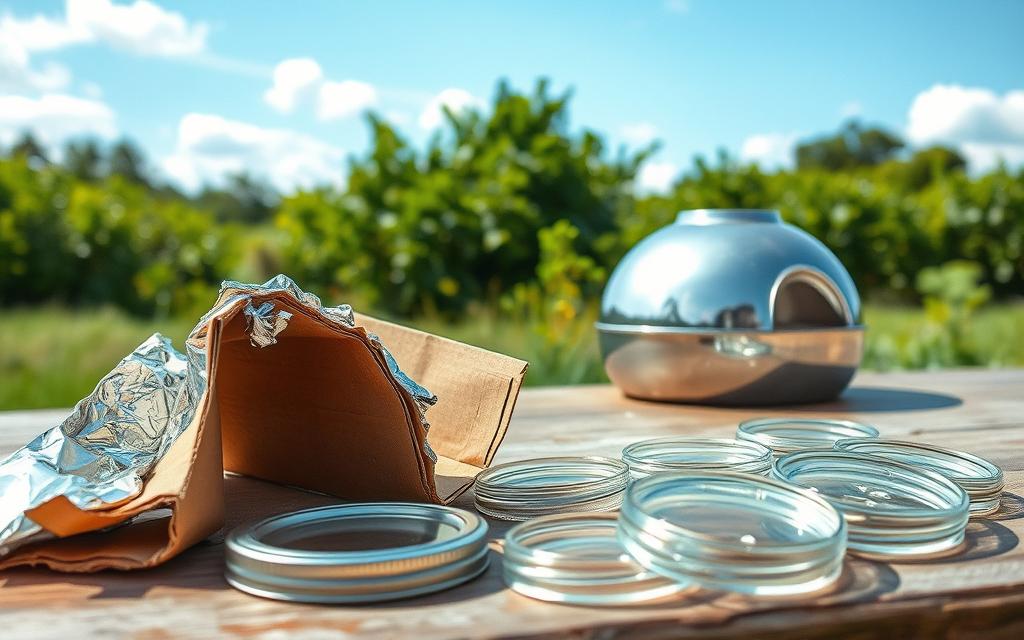
Defining Solar Ovens
A solar oven cooks food using direct sunlight. It can also heat and pasteurize food. These ovens have special features that make them work well.
- Reflective surfaces to concentrate solar energy
- Insulated cooking chamber
- Dark-colored interior to absorb maximum heat
- Transparent cover to trap solar radiation
Advantages of Solar Energy in Cooking
Solar cooking is good for people and the planet. It offers many benefits that make it worth trying.
- Zero fuel costs
- Reduced environmental impact
- Minimal carbon emissions
- Safe cooking in areas with limited resources
Understanding Solar Cooking Science
Solar cooking works because of simple physics. The sun’s radiant energy becomes heat through special surfaces. These surfaces reflect and absorb light.
Careful design helps collect more heat. In the best conditions, temperatures can reach 300-350 degrees Fahrenheit.
Solar ovens prove that sustainable technology can be both practical and accessible to everyone.
Materials You Will Need
Building a solar box cooker is an exciting renewable energy project. It turns everyday items into an eco-friendly cooking solution. This section lists the materials and tools you’ll need for your solar oven.
Recycled Items List
Gathering materials for your solar box cooker can be fun. You can repurpose many household items. Here’s what you’ll need:
- Large cardboard box
- Aluminum foil or reflective emergency blanket
- Black paint or black construction paper
- Clear plastic wrap or glass lid
- Old newspapers for insulation
Tools Required for Construction
The right tools will make your project easier. Prepare your workspace with these items:
- Scissors or utility knife
- Measuring tape
- Ruler
- Adhesive or glue gun
- Paintbrush (if using paint)
Safety Gear and Precautions
Safety is key when creating your solar cooker. Protect yourself with these items:
| Safety Item | Purpose |
|---|---|
| Safety glasses | Protect eyes during cutting and construction |
| Work gloves | Prevent cuts and protect hands |
| Dust mask | Avoid inhaling particles during cutting |
“The best solar box cooker is one built with care, creativity, and commitment to sustainable living.”
You’re now ready to start your solar cooking project. Approach it with patience and excitement. Your efforts will result in a unique, eco-friendly cooking device.
Step-by-Step Construction of Your Solar Oven
Building a solar oven is a fun way to cook green. You’ll turn recycled items into a powerful cooking tool. This project cuts your carbon footprint and lets you cook with the sun.
Get your recycled materials ready before you start. Set up a clean workspace. Good planning and careful building are key to success.
Preparing the Base
Your oven’s base is crucial for stability and performance. Choose a strong material that can handle heat and outdoor use.
- Cardboard box (thick, corrugated preferred)
- Wooden crate
- Rigid plastic container
Assembling the Reflective Panels
Reflective panels capture and focus solar energy. They’re vital for eco-friendly cooking. Your goal is to soak up as much sunlight as possible.
- Clean aluminum foil or reflective emergency blankets
- Cut panels to match base dimensions
- Carefully attach reflective material using non-toxic adhesive
Creating the Cooking Chamber
The cooking chamber is your oven’s core. Good insulation keeps heat in effectively.
| Material | Insulation Quality | Availability |
|---|---|---|
| Glass | Excellent | Easy to find |
| Plexiglass | Very Good | Readily available |
| Clear plastic | Good | Inexpensive |
Pro tip: Dark-colored interior surfaces absorb and keep more heat. This boosts your solar oven’s cooking power.
Insulation Techniques for Optimal Performance
Effective solar ovens need careful insulation. It’s crucial for off-grid cooking and heat retention. Good insulation turns a basic solar oven into an efficient cooking tool.
Proper insulation has multiple benefits in solar oven design. It traps heat inside and prevents loss to the environment. It also maintains cooking temperatures and improves overall efficiency.
Essential Insulating Materials
Consider these eco-friendly options for your solar oven insulation:
- Recycled newspaper – Shredded and packed tightly
- Natural wool or cotton batting
- Cardboard layers
- Styrofoam sheets
- Reflective aluminum foil
Insulation Application Techniques
To insulate your solar oven effectively, follow these key steps:
- Create multiple layers of insulation
- Ensure complete coverage of the oven walls
- Use materials that can withstand high temperatures
- Seal any potential heat escape points
Good insulation is key to maximizing your solar oven’s potential. It can boost cooking temperatures by up to 50%. This makes off-grid cooking more efficient and enjoyable.
Solar Oven Design Ideas
DIY solar ovens offer sustainable cooking options. Various designs suit different skill levels and needs. Let’s explore innovative homemade solar cooker techniques to find your perfect match.
Basic Box Oven Design
The basic box model is ideal for beginners. It needs few materials and skills. Key parts include a cardboard or wooden box and reflective aluminum foil.
You’ll also need a black cooking pot and clear glass cover. This design creates a heating chamber reaching 200-250°F.
- Cardboard or wooden box
- Reflective aluminum foil
- Black cooking pot
- Clear glass or plastic cover
Parabolic Solar Oven Design
Parabolic designs offer higher efficiency for advanced enthusiasts. Their curved surface focuses sunlight, creating intense heat. Materials may include curved metal sheets and reflective mylar.
You’ll need precise angle calculations and a sturdy mounting structure. This design allows for more powerful cooking capabilities.
- Curved metal sheets
- Reflective mylar
- Precise angle calculations
- Sturdy mounting structure
Advanced Designs for Enthusiasts
Skilled builders can try complex designs with tracking mechanisms. These may include multiple reflective panels. These advanced configurations maximize solar energy capture.
They provide more consistent cooking temperatures. This expands your culinary possibilities with solar cooking.
Pro tip: Always prioritize safety and precision when constructing advanced solar cooking equipment.
Testing Your Solar Oven
It’s time to test your newly built solar oven. Solar cooking needs patience and practice. This section will guide you through your first solar cooking experience.
Mastering sun oven prep and cooking techniques takes time. You’ll learn unique methods for harnessing the sun’s power.
First Cook: What to Expect
Your first solar cooking try might not be perfect. But it will be rewarding. Expect cooking times and temperatures to vary.
Solar ovens work best at midday when sunlight is strongest. Start with simple recipes like:
- Baked potatoes
- Rice dishes
- Slow-cooked vegetables
Troubleshooting Common Issues
Solar cooking can bring unique challenges. Watch for these potential problems:
- Uneven heating: Adjust the oven’s angle towards the sun
- Temperature fluctuations: Use a thermometer to monitor heat
- Slow cooking times: Ensure maximum sun exposure
Making Adjustments for Better Performance
To improve your sun oven, observe carefully. Track cooking times and monitor temperatures. Make small adjustments as needed.
Consider reflective panel positioning and insulation upgrades. These can boost your solar cooking efficiency.
“Practice makes perfect in solar cooking” – Solar Energy Enthusiasts
Each solar oven is unique. Your design may need specific tweaks to work best. Patience and experimentation are key.
Keep trying different methods. You’ll soon master solar cooking techniques.
Cooking with a Solar Oven
Solar box cookers offer a sustainable way to prepare tasty meals. These devices turn sunlight into cooking power, reducing your carbon footprint. They open up new possibilities for eco-friendly cooking.
Solar ovens excel at slow, even heating. This unique method requires different approaches than traditional cooking. Certain foods work best in these innovative cookers.
Best Foods for Solar Cooking
- Stews and casseroles
- Rice and grains
- Roasted vegetables
- Baked breads
- Slow-cooked meats
Cooking Times and Temperature Management
Sunlight intensity and cooker positioning affect temperature control. Solar box cookers typically reach 200-300°F, similar to slow cookers. Proper management ensures delicious results.
| Food Type | Approximate Cooking Time | Temperature Range |
|---|---|---|
| Vegetables | 1-2 hours | 200-250°F |
| Meat Dishes | 2-4 hours | 250-300°F |
| Baked Goods | 1-3 hours | 225-275°F |
Simple Solar Oven Recipes
Try these easy recipes designed for solar box cookers:
- Solar Rice Pilaf
- Slow-Roasted Vegetable Medley
- Sun-Baked Chicken Casserole
Learn to adjust your solar oven’s position for optimal results. Understanding cooking times helps you master this eco-friendly technique. With practice, you’ll create delicious meals using the sun’s power.
Environmental Impact of Using Solar Ovens
Solar ovens offer an eco-friendly cooking solution. They reduce environmental strain and provide a sustainable food preparation alternative. Green cooking methods like solar ovens transform how we approach meal preparation.
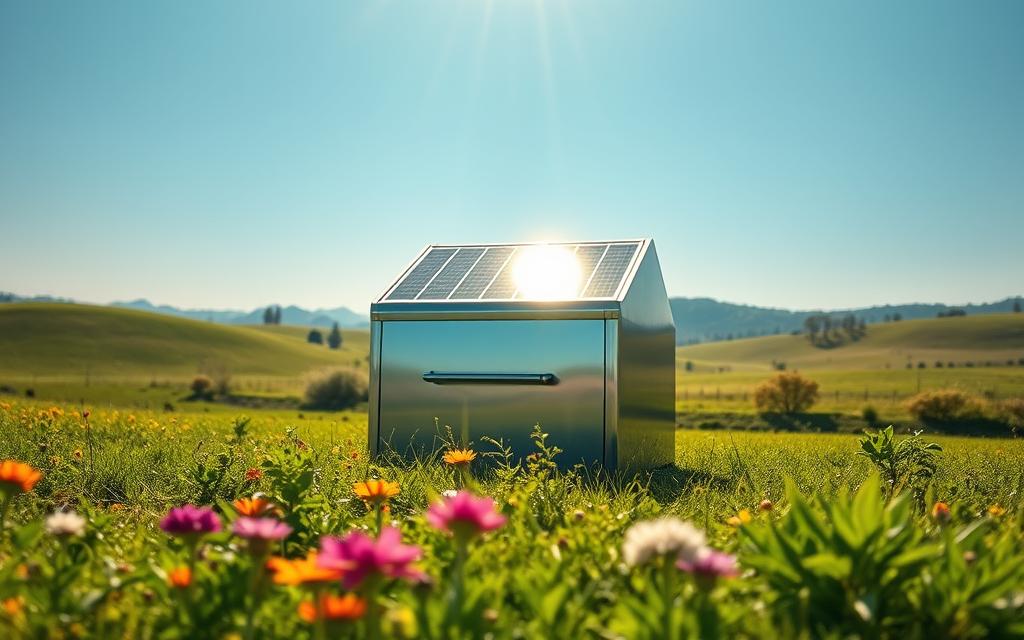
Solar ovens do more than just save energy. They provide multiple ecological benefits. These devices address critical sustainability challenges in innovative ways.
Reducing Carbon Footprint
Solar ovens cut greenhouse gas emissions by avoiding fossil fuels and electricity. Families using solar cooking can slash their carbon output significantly.
- Eliminate wood burning and associated deforestation
- Reduce carbon emissions by up to 70%
- Minimize reliance on non-renewable energy sources
Benefits to Local Ecosystem
Green cooking technologies help protect local environments. Solar ovens preserve forests and reduce air pollution. They create sustainable cooking practices that support ecological balance.
Sustainability of Recycled Materials
Building solar ovens with recycled materials boosts their environmental impact. Upcycling resources for solar cooking cuts waste. It shows creative ways to live sustainably.
- Repurpose plastic containers
- Use discarded reflective materials
- Transform waste into functional cooking solutions
“Every solar oven represents a step toward environmental healing and sustainable living.”
Future of Solar Cooking
Solar cooking tech is evolving fast. It offers sustainable, off-grid cooking solutions. New designs improve efficiency and accessibility for diverse global communities.
Solar cooking is key in fighting climate change. It helps reduce carbon emissions significantly. New tech offers better heat retention and faster cooking times.
Compact designs make off-grid cooking more appealing. They work well for both urban and rural areas. This makes solar cooking a practical choice for many.
Community programs boost solar cooking worldwide. They teach people to build and use solar ovens. This empowers communities to use renewable cooking tech.
These efforts show solar cooking’s many benefits. It’s good for the environment and promotes economic resilience. It also helps communities become energy independent.
Organizations like Solar Cookers International are leading innovation. They create lightweight, portable models with high-efficiency materials. These advances make solar cooking more accessible than ever.
As awareness grows, solar cooking’s future looks bright. It’s set to change how people cook worldwide. This tech offers a sustainable solution for global cooking needs.
FAQ
What exactly is a solar oven?
A solar oven cooks food using sunlight. It has reflective panels that focus solar energy into an insulated chamber. This device turns sunlight into heat without using electricity or fossil fuels.
How hot can a homemade solar oven get?
A well-built solar oven can reach 200-350°F. The temperature depends on design, sunlight intensity, and weather conditions. Best cooking happens on clear, sunny days with direct sunlight.
What materials can I use to build a solar oven?
You can use cardboard boxes, aluminum foil, and black paint. Glass or plastic covers, newspapers for insulation, and reflective surfaces work well too. Pizza boxes, tin foil, and old windows are also useful items.
Is cooking with a solar oven safe?
Solar ovens are safe when built and used correctly. They cook at lower temperatures than regular ovens. Use protective gloves and follow safety guidelines during construction and cooking.
What types of food work best in a solar oven?
Solar ovens excel at slow-cooking foods like stews, rice, and beans. Casseroles and baked goods also turn out well. Foods needing steady, moderate heat are ideal.
How long does it take to cook food in a solar oven?
Cooking times vary based on sunlight and food type. Most meals take 1-4 hours to cook fully. Outside temperature, cloud cover, and oven design affect cooking duration.
Can I use a solar oven in cold or cloudy weather?
Solar ovens work best in direct sunlight. They can function in partly cloudy conditions, but cooking takes longer. Cold or overcast weather makes solar cooking less effective.
What are the environmental benefits of using a solar oven?
Solar ovens cut carbon emissions and reduce reliance on fossil fuels. They help prevent deforestation by lowering wood fuel use. These ovens offer a sustainable cooking method that supports renewable energy.
How much does it cost to build a DIY solar oven?
Most DIY solar ovens cost under $20 to make. The price depends on what you have at home. You might need to buy some reflective or insulating materials.
Are solar ovens practical for everyday cooking?
Solar ovens work best in sunny areas with steady daylight. They’re great for certain meals but not ideal for all cooking. Use them as an extra cooking method, not a full replacement.

